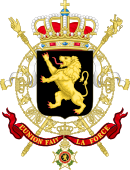
Back دستور بلجيكا Arabic Канстытуцыя Бельгіі Byelorussian Constitució de Bèlgica Catalan Belgiens forfatning Danish Verfassung des Königreichs Belgien German Σύνταγμα του Βελγίου Greek Konstitucio de Belgio Esperanto Constitución de Bélgica Spanish قانون اساسی بلژیک Persian Constitution de la Belgique French
| Constitution of Kingdom of Belgium | |
|---|---|
 Constitution of Belgium (1931) | |
| Overview | |
| Original title | (in French) Constitution du 7 février 1831 |
| Jurisdiction | Belgium |
| Ratified | 7 February 1831 |
| Date effective | Before 21 February 1831 |
| System | Parliamentary Monarchy |
| Government structure | |
| Branches | Three (executive, legislature and judiciary) |
| Chambers | Two (Senate and Chamber of Representatives) |
| Executive | King and their Government responsible to the Chamber of Representatives; Prime minister as head of government |
| Judiciary | Court of Cassation |
| Federalism | Federal, with 3 regions and 3 communities |
| Last amended | 2017 |
| Full text | |
 |
|---|
|
|
The Constitution of Belgium (Dutch: Belgische Grondwet; French: Constitution belge; German: Verfassung Belgiens) dates back to 1831. Since then Belgium has been a parliamentary monarchy that applies the principles of ministerial responsibility for the government policy and the separation of powers.
The most recent major change to the constitution was the introduction of the Court of Arbitration, whose competencies were expanded by a special law of 2003, to include Title II (Articles 8 to 32), and the Articles 170, 172 and 191 of the Constitution. The Court developed into a constitutional court; in May 2007 it was formally redesignated as the Constitutional Court. This court has the authority to examine whether a law or a decree is in compliance with Title II and Articles 170, 172 and 191.